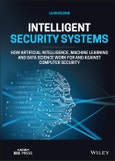Dramatically improve your cybersecurity using AI and machine learning
In Intelligent Security Systems, distinguished professor and computer scientist Dr. Leon Reznik delivers an expert synthesis of artificial intelligence, machine learning and data science techniques, applied to computer security to assist readers in hardening their computer systems against threats. Emphasizing practical and actionable strategies that can be immediately implemented by industry professionals and computer device’s owners, the author explains how to install and harden firewalls, intrusion detection systems, attack recognition tools, and malware protection systems. He also explains how to recognize and counter common hacking activities.
This book bridges the gap between cybersecurity education and new data science programs, discussing how cutting-edge artificial intelligence and machine learning techniques can work for and against cybersecurity efforts.
Intelligent Security Systems includes supplementary resources on an author-hosted website, such as classroom presentation slides, sample review, test and exam questions, and practice exercises to make the material contained practical and useful. The book also offers: - A thorough introduction to computer security, artificial intelligence, and machine learning, including basic definitions and concepts like threats, vulnerabilities, risks, attacks, protection, and tools - An exploration of firewall design and implementation, including firewall types and models, typical designs and configurations, and their limitations and problems - Discussions of intrusion detection systems (IDS), including architecture topologies, components, and operational ranges, classification approaches, and machine learning techniques in IDS design - A treatment of malware and vulnerabilities detection and protection, including malware classes, history, and development trends
Perfect for undergraduate and graduate students in computer security, computer science and engineering, Intelligent Security Systems will also earn a place in the libraries of students and educators in information technology and data science, as well as professionals working in those fields.
Table of Contents
Acknowledgments ix
Introduction xi
1 Computer Security with Artificial Intelligence, Machine Learning, and Data Science Combination: What? How? Why? And Why Now and Together? 1
1.1 The Current Security Landscape 1
1.2 Computer Security Basic Concepts 7
1.3 Sources of Security Threats 9
1.4 Attacks Against IoT and Wireless Sensor Networks 13
1.5 Introduction into Artificial Intelligence, Machine Learning, and Data Science 18
1.6 Fuzzy Logic and Systems 31
1.7 Machine Learning 35
1.8 Artificial Neural Networks (ANN) 43
1.9 Genetic Algorithms (GA) 50
1.10 Hybrid Intelligent Systems 51
Review Questions 52
Exercises 53
References 54
2 Firewall Design and Implementation: How to Configure Knowledge for the First Line of Defense? 57
2.1 Firewall Definition, History, and Functions: What Is It? And Where Does It Come From? 57
2.2 Firewall Operational Models or How Do They Work? 65
2.3 Basic Firewall Architectures or How Are They Built Up? 70
2.4 Process of Firewall Design, Implementation, and Maintenance or What Is the Right Way to Put All Things Together? 75
2.5 Firewall Policy Formalization with Rules or How Is the Knowledge Presented? 82
2.6 Firewalls Evaluation and Current Developments or How Are They Getting More and More Intelligent? 96
Review Questions 104
Exercises 106
References 107
3 Intrusion Detection Systems: What Do They Do Beyond the First Line of Defense? 109
3.1 Definition, Goals, and Primary Functions 109
3.2 IDS from a Historical Perspective 113
3.3 Typical IDS Architecture Topologies, Components, and Operational Ranges 116
3.4 IDS Types: Classification Approaches 121
3.5 IDS Performance Evaluation 131
3.6 Artificial Intelligence and Machine Learning Techniques in IDS Design 136
3.7 Intrusion Detection Challenges and Their Mitigation in IDS Design and Deployment 159
3.8 Intrusion Detection Tools 163
Review Questions 172
Exercises 174
References 175
4 Malware and Vulnerabilities Detection and Protection: What Are We Looking for and How? 177
4.1 Malware Definition, History, and Trends in Development 177
4.2 Malware Classification 182
4.3 Spam 214
4.4 Software Vulnerabilities 216
4.5 Principles of Malware Detection and Anti-malware Protection 219
4.6 Malware Detection Algorithms 229
4.7 Anti-malware Tools 237
Review Questions 240
Exercises 242
References 243
5 Hackers versus Normal Users: Who Is Our Enemy and How to Differentiate Them from Us? 247
5.1 Hacker’s Activities and Protection Against 247
5.2 Data Science Investigation of Ordinary Users’ Practice 273
5.3 User’s Authentication 288
5.4 User’s Anonymity, Attacks Against It, and Protection 301
Review Questions 309
Exercises 310
References 311
6 Adversarial Machine Learning: Who Is Machine Learning Working For? 315
6.1 Adversarial Machine Learning Definition 315
6.2 Adversarial Attack Taxonomy 316
6.3 Defense Strategies 320
6.4 Investigation of the Adversarial Attacks Influence on the Classifier Performance Use Case 322
6.5 Generative Adversarial Networks 327
Review Questions 333
Exercises 334
References 335
Index 337








